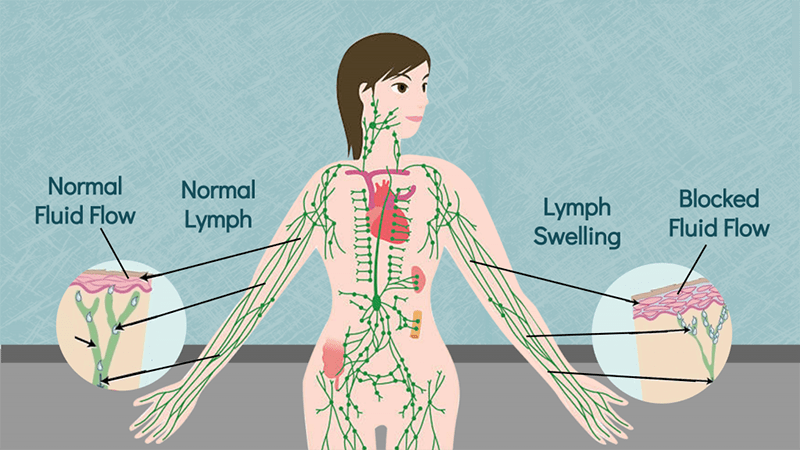
Conditions and Disorders
What conditions and disorders affect the lymphatic system?
Many conditions can affect the various parts of your lymphatic system. Some happen during development before birth or during childhood. Others develop as a result of disease or injury. Some common diseases and disorders of the lymphatic system include:
Swollen lymph nodes (lymphadenopathy). Infection, inflammation and cancer cause swollen (enlarged) lymph nodes. Common infections that can cause enlarged lymph nodes include strep throat, mononucleosis, HIV and infected skin wounds.
Lymphadenitis refers to lymphadenopathy that’s caused by an infection or inflammatory condition.
Swelling or accumulation of fluid (lymphedema). A blockage in your lymphatic system due to scar tissue from damaged lymph vessels or nodes can cause lymphedema. It can also happen when your lymph nodes have been removed to treat a condition like cancer. With lymphedema, fluid most commonly builds up in your arms or legs. It can be very mild or quite painful and disabling. People with lymphedema are at risk for serious and potentially life-threatening deep skin infections.
Cancers of the lymphatic system.
Lymphoma is cancer of the lymph nodes that occurs when lymphocytes grow and multiply uncontrollably. There are several different types of lymphoma, including Hodgkin’s lymphoma and non-Hodgkin’s lymphoma.
Cancerous tumors can also block lymphatic ducts or be near lymph nodes and interfere with the flow of lymph through the node.
Other disorders include:
Lymphangitis.
This is an inflammation of your lymph vessels.
Lymphangioma.
This is a condition that you’re born with. It involves the presence of noncancerous, fluid-filled bumps (cysts) under your skin due to overgrown lymph vessels.
Intestinal lymphangiectasia.
Loss of lymph tissue in your small intestine leads to loss of protein, gamma globulins, albumin and lymphocytes.
Lymphocytosis.
With this condition, there’s a higher-than-normal amount of lymphocytes in your body.
Lymphatic filariasis. This is a parasitic infection that causes the lymphatic system to malfunction.
Castleman disease. Castleman disease involves an overgrowth of cells in your body’s lymphatic system.
Lymphangioleiomyomatosis. This is a rare disease in which abnormal muscle-like cells begin to grow out of control in your lungs, lymph nodes and kidneys.
Autoimmune lymphoproliferative syndrome. This is a rare genetic disorder in which there’s a high number of lymphocytes in your lymph nodes, liver and spleen.
Mesenteric lymphadenitis. This is an inflammation of the lymph nodes in your belly (abdomen).
Lymphedema and lymphatic disorders refer to diseases that affect the lymphatic system — the network of tissues, vessels, and organs that move a specific fluid called lymph throughout the body. They occur when the lymphatic system is damaged or blocked, preventing lymph from circulating normally.
Left untreated, these disorders can cause pain, itching, swelling, and other complications such as skin infections.
Treatment for lymphedema and lymphatic disorders will depend on your diagnosis, stage of lymphedema, and related medical problems. Treatment may include manual lymphatic therapies, compression bandaging, therapeutic exercise, compression garments pneumatic pumps, dietary management, or surgery.
Lymphedema
The most common lymphatic disease is lymphedema. It is swelling of a body part caused by a lymphatic fluid buildup in the tissues. Lymphedema most often occurs in the arms and legs, but it can also affect the head, chest, breast, abdomen, and genitals. Lymphedema occurs when a blocked or damaged lymphatic system causes fluid to build up in the limbs, and lymph can’t flow through the body as normal. Lymphedema is the most common lymphatic and venous disorder.
Depending on your diagnosis, you may require treatment from:
- physical and occupational therapists
- physical medicine and rehabilitation specialists
- a team dedicated to treating cancer-related lymphedema
Lipedema
Lipedema causes excess fat to collect in the lower half of the body, primarily in the buttocks, thighs, and calves. It mainly affects women and typically runs in families.